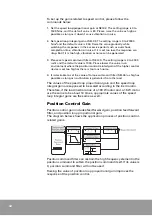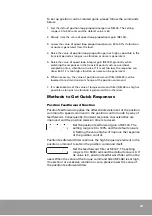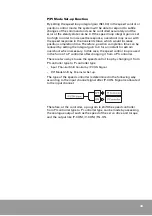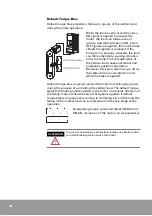
85
5
Tuning By Gain Adjustment
Overview
Users need to adjust the servo drive depending on the status of the
load in order to control different loads for the best performance. This is
the gain adjustment. And tuning is making the motor connected to the
drive perform its best through the gain adjustment.
Gains can be categorized as below.
•
System Gain
•
Basic Gain
•
Applied Gain
System gain is changed according to the inertia of the system and is
the same with the bandwidth of the servo drive’s overall speed control
loop. This gain can control the five basic gains at the same time.
•
System Gain (SEt-42)
Basic gain is categorized in five items that are essential for tuning.
•
Speed Loop Proportional Gain (Nms, SEt-02)
•
Speed Loop Integral Gain (Nms
2
, SEt-03)
•
Position Loop Proportional Gain (rad/s, SEt-04)
•
Torque Command Filter (rad/s, SEt-06)
•
Speed Command Filter (rad/s, SEt-40)
Applied gains are categorized into four items with distinct functions.
•
Position Command Filter (rad/s, SEt-35)
•
Vibration Suppression Filter (Hz, SEt-47)
•
Position Feedforward Gain (%, SEt-34)
•
Position Feedforward Filter (rad/s, SEt-07)
And there are four parameter needed for tuning.
•
P Control Shift Switch (SEt-54)
•
P Control Shift Reference Value (SEt-55, SEt-56, SEt-57)
•
Speed Bias Amount (RPM, SEt-38)
•
Speed Bias Application Range (pulse, SEt-39)
Summary of Contents for CSDP Plus
Page 1: ...Maximum Value for OEMs SM CSDP Plus Servo Drive User Manual...
Page 16: ...18...
Page 30: ...32 Higher Control Connector CN1 Circuit Diagram...
Page 33: ...35 Compact Absolute Encoder Wiring Serial Encoder Wiring...
Page 38: ...40...
Page 120: ...122...
Page 179: ...181 Speed Torque Curve...
Page 180: ...182...
Page 183: ...185 Speed Torque Curve...
Page 184: ...186...
Page 187: ...189...
Page 190: ...192 Speed Torque Curve...
Page 193: ...195...
Page 196: ...198...
Page 201: ...203...
Page 204: ...206...
Page 207: ...209...
Page 210: ...212...
Page 215: ...217...
Page 230: ...232...
Page 252: ...254...
Page 253: ......
















































